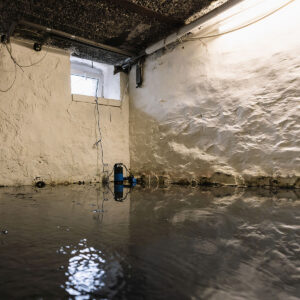
It’s important for homeowners to recognize the dangers associated with excess moisture buildup and take proactive steps to identify and prevent these risks before more serious issues arise. Let’s take a closer look at the dangers of still water and explore what to do to mitigate health hazards and structural risks.
The Dangers of Stagnant Water
Standing water is not only unsightly, but it can also bring along severe dangers for both your home and your home’s occupants. Even worse, if left untreated, standing water can turn into stagnant water, which is water that has been undisturbed for days. Standing and stagnant water can turn into a headache for homeowners.
Some of the most common dangers of standing water in your home and outside your home are:
- Bacteria: Floodwater contains many forms of bacteria and viruses including the Norwalk virus, E. coli, entamoeba giardia, cryptosporidium, and Salmonella. The bacteria from stagnant water can grow very quickly and lead to health problems. If you are in contact with standing water bacteria, be sure to protect yourself with gloves, long sleeves, and eye protection.
- Mold: Where there’s moisture, there’s a risk for mold growth. Floodwater creates an ideal environment for mold growth. The fast-growing fungus can cause damage to wood, and upholstery, and even worse, cause health issues such as respiratory issues, headaches, and irritation of the eyes and skin.
- Pests: Rodents and insects are attracted to water sources, even standing water. Mosquitoes are especially attracted to flood water and are known carriers of West Nile virus and malaria. According to the Centers for Disease Control and Prevention, mosquitoes are the main cause of the West Nile virus in the United States.
- Property Damage: Standing water or floodwater can be disastrous for the structural integrity of a home. The water can infiltrate a building’s foundation, weakening its overall stability, and causing cracks in its walls and floors. Floodwater can also damage a home’s electrical and heating systems, making the environment unsafe for its residents. Water that seeps into the attic can cause mold growth or mildew buildup that can potentially become a health risk. Additionally, standing water can also compromise a home’s insulation, ventilation, and air conditioning, leading to long-term structural damage and eventual financial loss.
If you have experienced a flood at your home, or have standing water in the basement or another area, it’s important to act quickly to prevent a bacterial outbreak, mold infestation, pest problem, or property damage. Because of the risks associated with standing water, it’s best to leave the cleanup to the professionals.
Preventing Standing Water
Flood water can not only be a nuisance but can also pose a significant health risk to people in the vicinity. It is essential to maintain a dry and hygienic environment both inside and outside the house to prevent and control water stagnation.
Here are a few preventive measures that can be employed to avoid standing water:
Correct Grading
Correct grading around a house is crucial in preventing outdoor standing water. The grading should slope downwards away from the house towards the street or any available drainage system. This will help in preventing water from seeping into the house’s foundation, causing structural damage and damaging the basement or crawl space. Installing a French drain can also help in directing water away from the house.
Gutter and Downspout Management
Cleaning gutters and downspouts regularly, especially during the fall season, helps in preventing clogging, which can cause water backup and eventual standing water. Downspouts should be installed strategically, directing water a few feet away from the foundation of the house. Downspouts should be extended at least six feet from the house.
Regular Interior Inspections
To mitigate standing water, inspect faucets and pipes for leaks and fix them promptly if needed. Drainage systems such as sinks, bathtubs, and showers should also be kept clean and unclogged. Also, regular airing of the house and removal of any water-damaged materials is critical in preventing mold growth, which thrives in damp environments.
Preventing standing water is a continuous process that requires regular maintenance and inspection of the house’s indoor and outdoor systems. Implementing the above preventive measures can significantly reduce the chances of standing water that can cause property damage, health hazards, and inconvenience.
Flood Water Cleanup
When it comes to cleaning up flood water, safety should always be a top priority. The presence of flood water can lead to the growth of harmful bacteria and the development of mold, so it’s important to take the necessary precautions before embarking on your cleanup mission.
First, ensure that you are wearing protective gear such as gloves, boots, and a respirator mask to avoid exposure to harmful germs and chemicals. It is crucial also to turn off any electrical sources, such as power outlets or electrical appliances, before entering the standing water.
To prevent the spread of contaminants, never use a household vacuum cleaner or wet-dry vacuum to remove water. Instead, use a mop or a squeegee to collect the water and then disinfect the affected area using a solution of water and bleach (one cup of bleach per gallon of water).
After the cleanup, allow the area to dry thoroughly and avoid using the space until all surfaces have been completely disinfected and dried. If the standing water is due to a leak or flooding caused by severe weather conditions, it is recommended to contact a professional restoration company to ensure a thorough and safe cleanup.
Remember: safety comes first when it comes to cleaning up standing water.
Flood Damage and Water Mitigation Restoration Services
Reynolds Restoration Services is here to help home and business owners with complicated cleanup after a flood, severe weather, or other water loss. Flood water can be a breeding ground for pests, bacteria, and viruses, and our team has the right equipment and training to get the job done safely and quickly.
We are on call 24/7 with the goal to always Respond and Rebuild with Care. With offices in Harrisburg, Pa., Philadelphia, Pa., and the Baltimore, Md./DC Metro area, we can be on site quickly to assess the emergency situation and get to work. Call us anytime at 1-888-277-8280!

President of Reynolds Restoration Services. Over 20 years of experience in the emergency restoration industry.

